Viva los toros. Posters for reflection
|
Viva los toros
Posters for reflection
From 4 November 2010 to 23 January 2011
Sala
Estudi General – La Nau
Opening hours: from Tuesday to Saturday, from 10 to 14 h
and from 16 to 20 h. Sundays and bank holidays,
from 10 to 14 h. ADMISSION IS FREE. |
|
|
|
50 Posters [+] |
Vídeo "Vivan los toros" (wmv - 56')
[+] |
|
Poster [+] |
Hoja de Mano [+] |
|
|
|
 |
|
|
|
Organised by the University of Valencia
Produced by the General Foundation of the University of
Valencia
With cooperation from ADCV (Asociación Diseñadores de
la Comunidad Valencia)
www.adcv.com, Universidad Politécnica de Valencia y Jaume I University (Castelló)
Project management: Boke Bazán
General coordination: Norberto Piqueras
Introduction
We all remember the magnificent posters made in Paris by
Jules Chéret after 1886. He was the first artist to
exclusively focus on posters and the great promoter of
lithographic process improvement applied to
reproduction, which he achieved in his own printing
workshop, managing to reproduce several colours in the
same poster. The progress made left behind xylographic
works in just one colour, with simple drawings or with
types only. Gradually, the urban landscape of Paris and
its austere walls began to be covered with adverts of
great and colourful shows. Other artists like
Toulouse-Lautrec, despite his short production (he only
made 32 posters over his short lifetime), contributed a
unique and specific language to this new extremely
attractive and effective means of communication.
The affiches soon became the main instrument of
mass communication. Some advertisers saw in them a huge
opportunity to position themselves; this was the case
with well-known and paradigmatic advertising campaigns
like Bibendum in 1898 by Marius Rossillon for
Michelin, or here in Spain, the posters made in
Barcelona by Ramón Casas for
Anís del Mono,
still remembered by many.
The commercial success
of advertisers consolidated the importance of posters as
the essential tool of advertising communication in the
late 19th century.
Although in the early years of the new century Valencia
did not yet follow the pace of modern artistic
contributions from other European cities, the city had
kept an artistic tradition and, like elsewhere, some
painters complemented their production and income with
ads and posters for local businesses. Although the Civil
War was the saddest event in the history of
twentieth-century Spain, more than two thousand posters
with political and military propaganda of both sides
were designed and printed in those three years.
Valencian artists such as Josep Renau, Manuel Monleón,
Rafael Raga, Enrique Climent, the brothers Arturo and
Vicente Ballester, Cabedo Torrent, Debón, Petit Guillem
or Pérez Contel, wholeheartedly devoted themselves to
this task on the basis of their Republican political
commitment and conviction: this devotion was very much
in line with the phrase The army of art which the
poet Mayakovsky came up with for all those artists who,
putting painting and sculpture apart, focused on
printing work to put their ideas and proposals into mass
production. At present, the large number of posters of
the civil war, which were created for the various
ministries and trade unions, with great freedom, make up
an enormous graphic heritage of great value and interest
both historically and plastically. Although most authors
wanted to have a highly realistic visual and emotional
impact with their images, in order to exert such
influence many of them had to use the language of the
avant-gardes, which oddly enough led to its crisis and
disappearance after the war in Spain and World War II.
The result of the high demand for posters and the
relative freedom that the artists enjoyed, a heritage of
great value and interest was created. In fact we could
say that these authors, aware of what was happening in
Europe, brought the avant-garde language to Valencia.
|
|
|
|
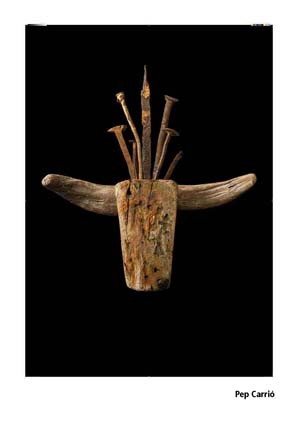
© Pep Carrió |

© Ortifus |
|
|
|
In addition to billboards for shows like the circus or
Las Fallas, in the 1930s the artists also
produced posters for bullfights. As an avant-garde
author, Renau's graphic work is the best example; it
broke away from the classical discourse of bullfighting
posters made so far and whose "Golden Age", according to
some authors, took place between 1923 and 1931. At that
time there was a consolidated school of artists more or
less specialized in the bullfight poster, like Ramón
Casas, Julio Romero de Torres, Roberto Domingo, Alcaraz,
J. Reus, Saavedra, Antonio Casero, García Campos,
Martínez de León, Álvarez Carmena or Carlos Ruano Llopis
from Alicante, who was considered by many the most
refreshing, prominent and influential poster artist. To
all this we must add the contribution of such
distinguished artists like Sorolla or Benlliure, who
collaborated with some posters for charity bullfights.
Thus, a particular style was consolidated, laying the
foundations of the type of bullfighting posters that
have reached our day.
It is remarkable and thought-provoking to see that in
more than a century of bullfighting posters, unlike
other expressions of graphic design and other artistic
disciplines, nothing has changed
in their arguments,
compositions, or style. |
|
|
|

© Flavio Morais |
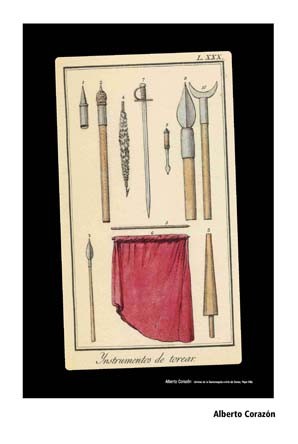
© Alberto Corazón |
|
|
|
Viva los toros.
Posters for reflection
2010. Culture and art are exercised and consumed in a
different manner from that of the past century.
Nowadays, it is all
right to think that our society is more educated, aware,
sensitive, critical and supportive, and that among other
things it is not indifferent to injustice, war and the
needy, inside and outside our borders. Proof of this are
the ongoing public demonstrations that advocate values
that differentiate us as a mature, advanced and
democratic society, a society with a voice that thinks
and feels, and is aware that it has the ability to
change things.
As cultural agents and communications specialists, from
a social and progressive commitment, a group of 50
illustrators and designers aware of their influence on
the media and society, have come together to contribute
to the debate about bullfights with a critical position
in their works: current images and texts that go beyond
the clichés.
This exhibition is defined as a totally independent,
reflective and open cultural proposal to all opinions.
It does not intend to promote bans but to connect with
an audience in search of knowledge, who requires
progressive ideas and is willing to reflect.
The exhibition started to be defined in January 2009 and
came true when the authors -invited out of affinity or
friendship- joined, with tremendous enthusiasm and
selflessly, a project that at the time did not even have
a site to exhibit the posters.
Based on the exhibition principles and interests of the
Department for Culture of Universitat de València in
programming and producing the poster show, the
exhibition “Viva los toros. Posters for reflection” will
be opened in October 2010 at La Nau. The show will
include works by exceptional artists from graphic design
and illustration, from different generations but with
great public prestige nationally and internationally
(some of them have been awarded the National Prize).
|
|
|
|
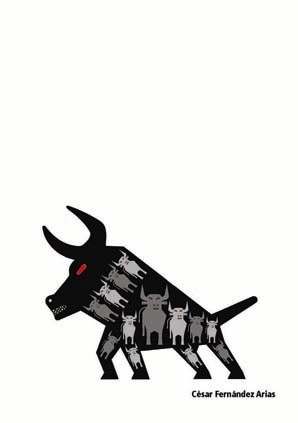
© César Fernández Arias |
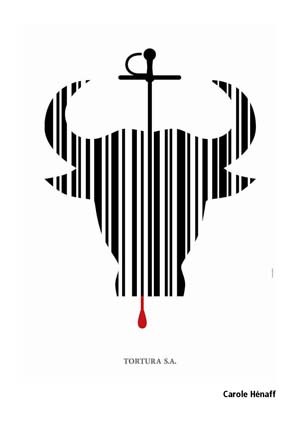
© Carole Hénaff |
|
|
|
The 50 authors are:
|
|
Ajubel
www.ajubel.com
Pablo Amargo
www.pabloamargo.com
Raquel Aparicio
www.raquelissima.com
Andreu Balius
www.andreubalius.com
Arnal Ballester
www.arnalballester.com
Dídac Ballester
www.didacballester.com
Mik Baro
www.mikbaroblog.blogspot.com
Paco Bascuñán
www.pacobascunan.com
Boke Bazán
www.bokebazan.com
Joaquín Blas
Miguel Calatayud
http://es.wikipedia.org/wiki/Miguel_Calatayud
Pep Carrió
www.carriosanchezlacasta.com
Alberto Corazón
www.albertocorazon.com
Kike Correcher
www.filmac.com
César Fdez. Arias
www.cesarfernandezarias.com
Isidro Ferrer
www.h2omagazine.com/expo37
Sandra Figuerola
www.sandrafiguerola.com
Marisa Gallén
www.marisagallen.com
Paco
Giménez
Pepe Gimeno
www.pepegimeno.com
Pilar Gorriz
www.pilargorriz.com
GeeOhDee
www.geeohdee.com
Carole Hénaff
www.carolehenaff.com
Enric Jardí + Berto Martínez
www.enricjardi.com
Mikel Jaso
www.mikeljaso.com
|
MacDiego
www.macdiego.com
Sean Mackaoui
www.mackaoui.com
Alejandro Magallanes
http://loquehacealejandromagallanes.blogspot.com
Chus Martínez
Juan Martínez
www.martinezestudio.com
Fernando Medina
http://es.wikipedia.org/wiki/Fernando_Medina
Pep Montserrat
www.pepmontserrat.com
Flavio Morais
www.flaviomorais.net
Mucho
www.mucho.ws
Juan Nava
www.juan-nava.com
Daniel Nebot
www.danielnebot.com
Javier Olivares
http://javierolivaresblog.blogspot.com
Ortifus
http://es.wikipedia.org/wiki/Ortifus
Carlos Ortín
www.apiv.com/guia de
ilustradores-carlos ortin
Peret
www.peret.com.es
Belén Payá
www.belenpaya.com
Uqui Permui
www.uquicebra.com
Paco Roca
www.pacoroca.com
Ibán Ramón
www.ibanramon.com
Nuria Rodríguez
www.nuriarodriguez.com
Alexis Rom
http://alexisromestudio.eu
Marc Taeger
www.marquski.com
Lina Vila
www.estudiolinavila.com
Martiño Villaverde
www.martinovillaverde.com
Cento Yuste
www.centoyuste.com |
|
|
|
|
After presenting the show at Universitat de València, it
will travel to other cultural centres in different
Spanish cities.
Boke Bazán
Designer and director of the exhibition project VIVA
LOS TOROS! Posters for reflection |
|
|
|
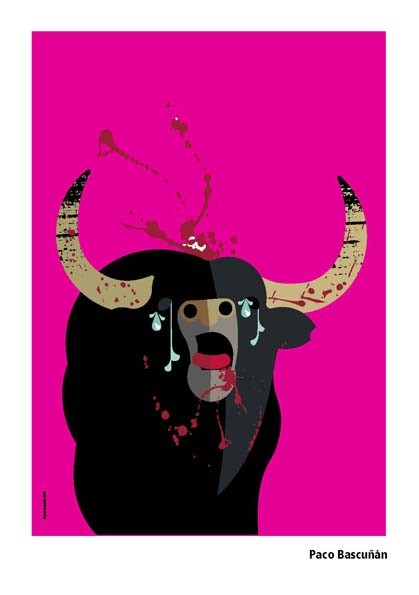
© Paco Bascuñán |
|
|
|
|
|